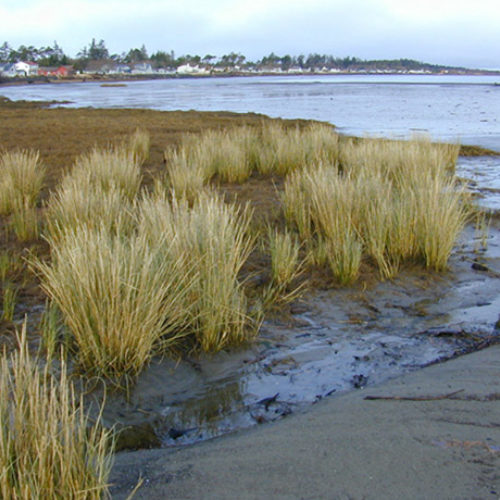Dense-Flowered Cordgrass
Spartina densiflora

Family: Poaceae
Weed class: A
Year Listed: 2003
Native to: South American coastal regions.
Is this Weed Toxic?:
not known to be
Legal listings:
This plant is also on the Washington State quarantine list. It is prohibited to transport, buy, sell, offer for sale, or distribute plants or plant parts of quarantined species into or within the state of Washington or to sell, offer for sale, or distribute seed packets of seed, flower seed blends, or wildflower mixes of quarantined species into or within the state of Washington. Please seeWAC 16-752 for more information on the quarantine list. For questions about the quarantine list, contact the Washington State Department of Agriculture's Plant Services Program at (360) 902-1874 or email PlantServices@agr.wa.gov.
Why Is It a Noxious Weed?
In general, the Spartina genus is considered highly invasive and one of the most aggressive worldwide. Spartina displaces native species, destroys wildlife habitat, interferes with recreational activities and is difficult and expensive to control.
How would I identify it?
General Description
Dense flowered cordgrass is a perennial salt tolerant grass that is upright in form, growing in dense tufted clumps.
Flower Description
The inflorescence is a spike, 2.4 to 11.8 inches long. The flowers are dense, compact and colorless.
Leaf description
The blades are narrow, long and in-rolled. Blades are tough, grayish in color and 1/4 to 1/3 inch wide.
Stem description
Culms hollow and range from 10.6 to 59 inches in height.
Where does it grow?
Dense flowered cordgrass grows in the upper intertidal zone, or mid to high marsh zones, near the mean high water mark, or just below it on open mud. Please click here to see a county level distribution map of dense flowered cordgrass in Washington.
How Does it Reproduce?
Unlike other Spartina species, this species reproduces only by seeds.
How Do I Control It?
General Control Strategy
Control methods of Spartina densiflora are thought to be similar to the other Spartina species. Information presented is based on results of other Spartina species.
Mechanical Control
Seedlings can be pulled out effectively though care should be taken to remove both shoots and roots. Covering small clones with woven geotextile fabric has been successful on Spartina patens. Mowing infestations can contain growth, limit seed set, and eventually kill the plants. To be effective, clones must be mowed repeatedly, beginning with initial spring green-up and continued until fall die-back. In some cases, repeated mowing will be required for three or four years.
Cultural Control
Diking can be used as a containment measure, since dikes confine the lateral spread of rhizomes. Diking blocks tidal flow, which stops nutrient flow and oxygen exchange. Prolonged flooding may eventually kill Spartina and other species that cannot tolerate standing water.
Herbicide Control
Please refer to the PNW Weed Managemnt Handbook, or contact your county noxious weed coordinator.
For More Information
See our Written Findings for more information about dense-flowered cordgrass (Spartina densiflora).
WSDA's Spartina Eradication Program
Whatcom County NWCB Fact Sheet on Spartina spp.






